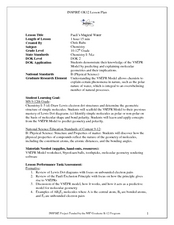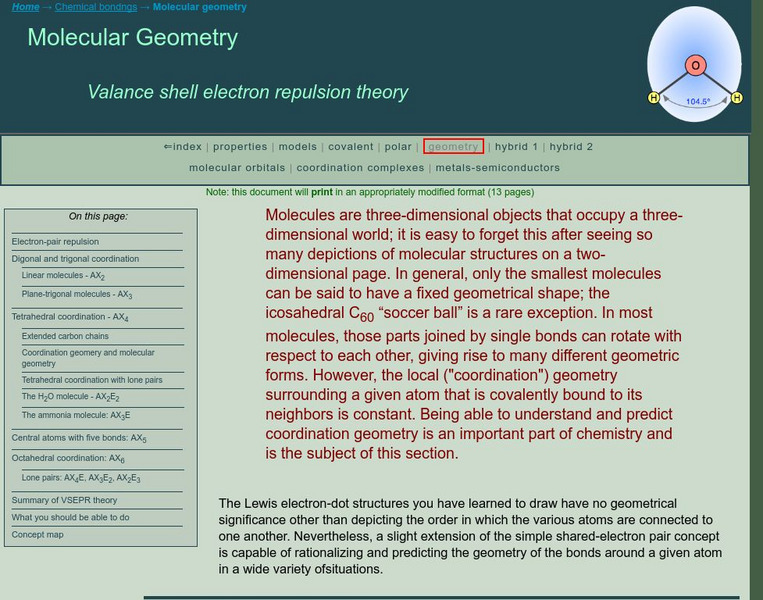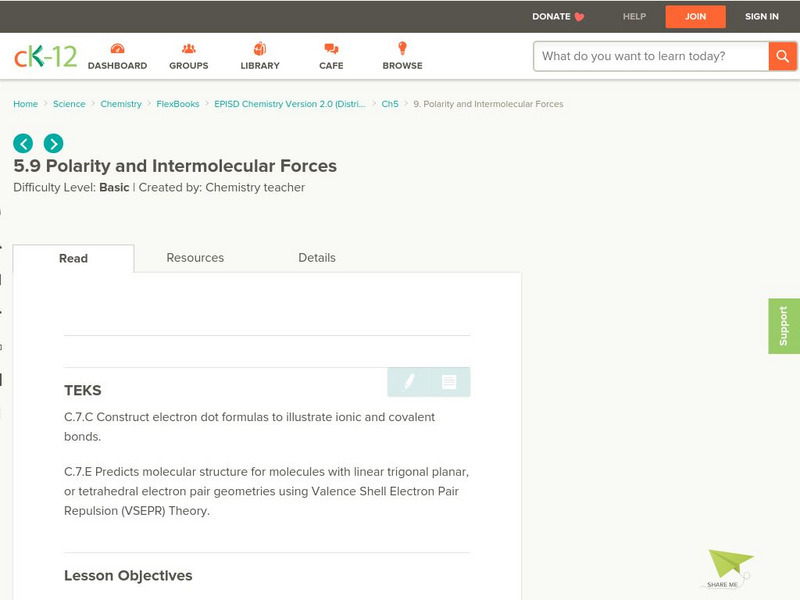Curated OER
Lewis Structure Worksheet
In this chemistry worksheet, students draw the Lewis structures of 9 compounds and polyatomic ions, identify their molecular shapes and polarity.
Curated OER
Lewis Structure Worksheet
In this chemistry worksheet, students draw the Lewis structures of 11 compounds and polyatomic ions. They calculate the formal charge of each atom.
Curated OER
Polarity and Bonding Worksheet
In this chemistry worksheet, 5th graders arrange molecules according to their polarity. They complete 5 sets of problems on hybridization and enthalpy of reactions.
Curated OER
Molecular Architecture
High schoolers cuminate their study of molecular structure and bonding with this activity.
Curated OER
Allotropes
Brilliant graphics depict a variety of allotropes, especially the allotropes of carbon. Some notes are available to help make these useful for teaching your young chemists, but not for every slide. With some additional preparation on...
Curated OER
Chemistry 151 - Final Review
In this chemistry review worksheet, students give atomic symbols for given atoms, calculate moles, determine empirical formulas, and balance chemical equations. This worksheet has 1 drawing, 9 fill in the blank, and 12 word problems.
Curated OER
VSEPR THEORY: BALLOONS AND MOLECULES
High schoolers listen to the teacher introduce VSEPR theory and explain molecular geometry. They use balloons to visualize the shape of orbitals. Students create visuals of molecular orbitals with strings and balloons.
Curated OER
Beads, Balls, and Beakers
Young scholars analyze the amount of space required to pack round objects. In this geometry instructional activity, students practice using space economically by practicing packing spheres into beakers. They then translate this concept...
Curated OER
Molecular Modeling Activity
Students work together to explain the VSEPR theory and how it relates to molecules. They name electron pairs that can surround the central atom of an organism. They discuss the factors that determine the polarity of a molecule as well.
Curated OER
Pauli's Magical Water
Students predict the shape of molecules using VSEPR theory. In this chemistry lesson, students differentiate a polar and nonpolar molecule. They discuss why water's polarity is very important.
Kenan Fellows
What Element Would You Be?
Primo Levi wrote a collection of short stories comparing his life from Italy to Auschwitz to elements in the periodic table. Pupils read an excerpt from his book and research the characteristics of various elements. Then, they make a...
Curated OER
How Are The Properties of Covalent Compounds Influenced By Chemical Bonding?
Students work together to observe the bond lengths of single, double and triple bonds. They make their own predictions about the strength of the bonds and chemical reactions. They answer discussion questions to complete the lesson.
National Institute of Open Schooling
Chemical Bonding
Name is Bond, covalent bond. Through readings and answering questions, classes explore the different types of chemical bonds, their characteristics, valence shell electron pair repulsion theory, and atomic orbitals.
CK-12 Foundation
Ck 12: Molecular Geometry
[Free Registration/Login may be required to access all resource tools.] In this interactive learning module, students will learn a technique to predict molecular geometry based on a molecule's Lewis electron dot structure.
CK-12 Foundation
Ck 12: Molecular Geometry
[Free Registration/Login may be required to access all resource tools.] The following online tutorial explains the basis of VSEPR theory. It helps students predict the shapes of molecules and polyatomic ions using VSEPR theory and it...
Simon Fraser University
Chem1 Virtual Textbook: Molecular Geometry
An advanced explanation of the valence shell electron pair repulsion (VSEPR) theory describes specific molecular models involving digonal, trigonal, tetrahedral, and octahedral coordination, as well as central atoms with five bonds....
Chiral Publishing
Chiral Publishing: An Introduction to Chemistry: Molecular Structure [Pdf]
The Molecular Structure chapter from "An Introduction to Chemistry" textbook discusses the formation of covalent bonds, drawing Lewis dot structures, and the resonance and molecular geometry of molecules. Many pictures and examples are...
Chiral Publishing
Chiral Publishing: An Introduction to Chemistry: Molecular Geometry From Lewis Structures
This audio book, by author Mark Bishop, describes how to draw geometric sketches of molecular compounds using lewis dot structures. Many examples are given to increase understanding. Also find links to animations and tutorials for other...
CK-12 Foundation
Ck 12: Polarity and Intermolecular Forces
[Free Registration/Login may be required to access all resource tools.] The following online tutorial describes how the electronegativity difference between two atoms in a covalent bond results in the formation of a nonpolar covalent,...
American Chemical Society
Middle School Chemistry: Represent Bonding With Lewis Dot Diagrams
Find out how molecular bonding is represented by Lewis dot diagrams.
Davidson College
Davidson College: Electronic Structure of Coordination Compounds
A list of five virtual chemistry topics with Java applets on the electronic structure of coordination compounds. Covers crystal field theory, CFT energy level splitting, color in gems, the spectrochemical series, and ligand properties.
Davidson College
Davidson College: Molecular Orbitals of Tetraamminecopper(ii)
A Java applet displays the Ligand Field Theory energy diagram for the Tetraamminecopper(II) ion. When an orbital in the diagram is clicked on, the isosurface is shown.
Davidson College
Davidson College: Molecular Orbitals of Diamminesilver(i)
A Java applet displays the Ligand Field Theory energy diagram for the Diamminesilver(I) ion. When an orbital in the diagram is clicked on, the isosurface is shown.
Chiral Publishing
Chiral Publishing: An Introduction to Chemistry: Molecular Structures: Tetrahedral Shape
Interact with molecules of methane, ammonia, and water, by manipulating colorful applets to see these molecules from all sides and observe their tetrahedral shapes.


















![Chiral Publishing: An Introduction to Chemistry: Molecular Structure [Pdf] eBook Chiral Publishing: An Introduction to Chemistry: Molecular Structure [Pdf] eBook](https://d15y2dacu3jp90.cloudfront.net/images/attachment_defaults/resource/large/FPO-knovation.png)
